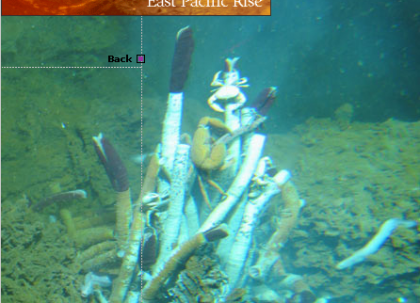11: Finale
Yesterday I signed off on another exploratory dive, devoting one of the two remaining Alvin dives of my cruise to a virtually unknown area. The basis of this decision was that I had always considered this site to be a very attractive target because it lies not on the ridge proper, but about 1.5 km to the east. Collections from this area would be a great way to find out how diversity at off-axis sites compares to that of on-axis sites. In addition, Giant Tube Worms (Riftia) from this site had rusty-colored coatings four years ago; Stephane Hourdez, who was on a cruise here with the French sub, the Nautile, told us he had seen the specimens collected from this site on deck. General knowledge is that rusty-colored areas are transient phases in the life of a vent. The rust indicates a high concentration of iron relative to sulfide in the fluids, and may be the last gasp of dying vent fields. An implicit liability in coming back now is that four years is a long time to expect a last gasp to last.
When I wrote the dive plan the night before, I had had qualms about my decision. As I signed off as Chief Scientist on the dive approval form ten minutes before the divers got into the sub, I was kicking myself for having made it. I envisioned Z and Stefani Smith, videographer for our web page, spending a long, frustrating day in Alvin searching for what was not there rather than, as had been the case during my dive to a known (and previously collected) vent the day before, filling Alvin's basket with specimens that are vital to documenting what exists on the seafloor, but it was way too late to change my mind.
At this stage of the cruise, a dive that didn't provide key samples for analyses by my on-board biologists would be a serious error. Each afternoon when the sub comes up with specimens from the bottom, my science party, lead by me, swarms the basket. We remove all the specimens the hydraulic-powered arm of Alvin plucked from the seafloor between 1.5 and 7 hours before. Each and every one of the up to ten specimen containers on the basket is cleared of its contents, whether animal or mineral (there is no vegetable on the seafloor), and all of the water in each box is siphoned or decanted. The water is then strained though a sieve with miniscule (0.25 mm) pores to make sure we keep all the tiny animals. All the specimens are then placed in buckets of ice-cold seawater, to minimize their stress from the tropical heat. The specimens are carried to the ship's walk-in cold room in individually labeled buckets. Every bit of every sample is examined for animal life and any rocks are sorted out and dried for examination by our on-board geologists. Each bit is labeled and preserved, and specimens are evaluated as potential photographic subjects by Peter and/or Todd. I would love to take credit for having assigned everyone his or her task, as each step is necessary. I would love to claim that I established the protocols for labeling and specimen handling, but my biologists did it all themselves, while I was doing something like planning the next day's dive.
The well-oiled machine my science party has become would come to a screeching halt if I make a bad decision on where to put a day's dive. In the afternoon, as people gather on the fan-tail after having carried 5-gallon buckets of ice-cold seawater nearly through the length of the ship to await the sub's return, I begin to grow concerned. All that human energy, all those interrupted afternoon naps, and all that enthusiasm that has been keeping us working until the early morning hours after a good dive would be crushed if an exploratory dive I okayed came back with minimal samples.
That's why I guess I had knots in my stomach that morning and a feeling that the bet had been a loser. That's also why when I heard Alvin was among "lots of Riftia" I was so happy. The French have investigated this site, but we think that ours was the third dive on the site in the 20 years since it has been discovered. The pristine character of these vents is stunning, its geology appears to be totally unexpected and its placement is enigmatic. It includes one of the largest hydrothermal sulfide deposits ever observed on the East Pacific Rise. Best of all, its animals are beautiful and include new species of anemones, a gastropod I've never seen before, and some of the oddest shaped and strangest colored Giant Tube Worms any of us have ever seen. I think you know that I am now intent on putting our last dive here too.





